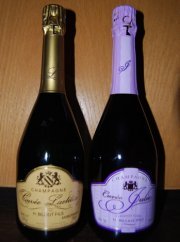Champagne -
The King of Sparkling Wines
What is Champagne?

Champagne is a region northeast of Paris in France. It is where the sparkling wine of the same name is exclusively produced. In fact, most wines in France are named for where they come from, not for the grapes in the wine or anything else. However, Champagne is one of the most famous of all of French wines.
Sparkling wine has been made in the region for centuries. While it is arguable who historically first produced sparkling wine, the producers in this region certainly perfected it. While sparkling wine abounds around the globe, from various grapes, regions and styles, this is still the gold standard by which most sparkling wines are judged. That is not to say that there are not sublime versions from elsewhere though.
A sparkling wine is a bubbly wine which has carbon dioxide dissolved in it, giving it effervescence, a fizzy, bubbly appearance and texture. For centuries these lively, complex and elegant sparkling wines have come to represent celebration and good living. There is something romantic, sexy, prestigious and simply fun about drinking a great Champs.
Of note, while sparkling wines of various types can be made anywhere in the world, only ones that come from this specific region in France can be called Champagne.
How Are They Made?
The sparkling wines here are made by the
Méthod Traditionelle or
Méthod Champenoise described on our
Sparkling Wine page. In general, this means that a still wine is first produced. This wine is then aged and then bottled. However, an addition of sugar and yeast to the bottle results in a secondary fermentation in the bottle which produces carbon dioxide, carbonating the wine. After the yeast sediment is removed by a process of
remuage, the bottles are corked and sold.
While bubbly can be made from almost any grape, Champagne generally only allows the growth and use of three varieties of grapes. There are two dark red grapes, Pinot Noir and Pinot Meunier. The only white grape allowed is Chardonnay. Many of the wines are blends of various amounts of all these grapes. The juice is only allowed to contact the skins briefly so that most of the wines are white. The exception are Rosé wines.
Some producers make wines exclusively from white or red (black) grapes. Sparkling wines that are made 100% from white grapes (Chardonnay) are labeled Blanc de Blancs, meaning white from white grapes. And the wines with exclusively red grapes (Pinot Noir and/or Pinot Meunier) are called Blanc de Noirs, meaning white from black grapes.
Of note, there are several styles produced, but in general most are either a NV (non-vintage) or a vintage Champagne. An NV is generally a blend of wines from two or more vintages whereas a vintage wine is one which comes exclusively from a single vintage and has that year listed on the label. In general, vintage Champs are only produced in the best years whereas each producer releases non-vintage wines continuously from previous vintages.
Many people don't realize that many Champagne can age well for many years. While most non-vintage wines are released when ready to drink, many of the best can hold or even improve for years after release. Most vintage wines will definitely improve with age in a cool cellar.
What Do They Taste Like and
What Foods Do You Eat with Them?
While they are all bubbly, these sparkling wines vary considerably from one to the next. In general they are bright, intense and flavorful with a lively acidity and sparkle. However, while some may be lean, tight and crisp, others are rounder, fatter and more lush. Some are very dry with little sugar added (such as
Brut Nature or
Extra Brut, while others have an added
dosage of sugar to give them a bit more sweetness and softness. Some are very sweet with high levels of
dosage (such as
Demi-Sec or
Doux).
Because of the yeast fermentation in the bottle, many have a toasty, yeasty quality to their aromas and flavors that some describe as "yeasty" or "doughy". The richer wines can also often have a buttery quality. Combined with the yeasty, doughiness they can almost be light a nicely buttered toast. The best have a silky elegance to them with complex aromas and bright lingering flavors.
Beyond these general descriptions, these sparkling wines can vary almost as much as any other wine, varying considerably depending on the types of grapes used, the region the grapes were grown and the particular house style of each producer.
Although they are often simply used for toasts and celebrations, there are many uses for these sparkling wines when entertaining. They make outstanding and elegant apéritifs. They are also brilliant with many foods. They can accompany everything from shellfish like oysters on the half shell (an awesome combination) to baked fish and poultry. Surprisingly they are also incredible with Asian cuisine such as Sushi and spicy Indian fare!
For more information and tips about pairing specific wines with food, be sure to check out our Food and Wine Pairing section!
If you want tips on how to open and serve Champagne, check out our How to Open Sparkling Wine page. Also, for even more fun, learn about opening Champagne with a Saber!
Done with the Champagne page?
Return to the Types of Wine page.
